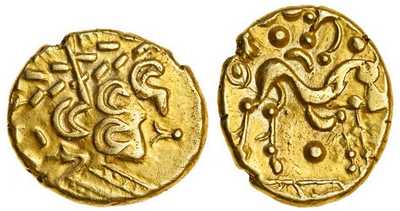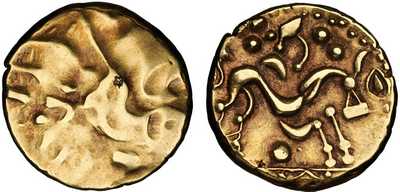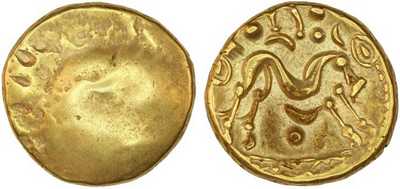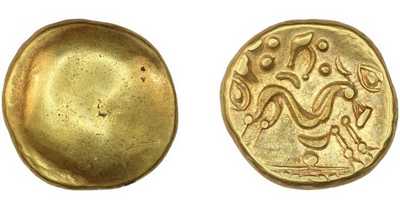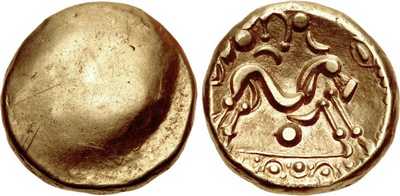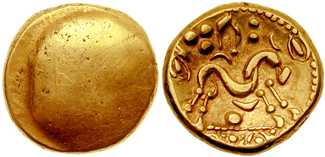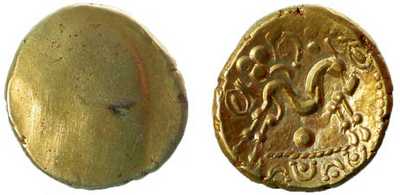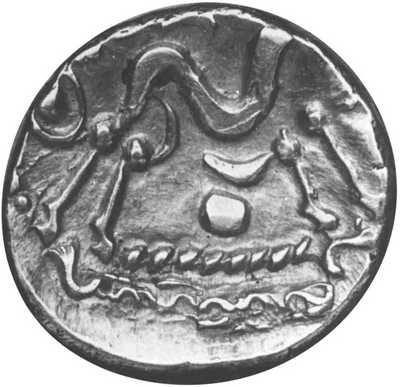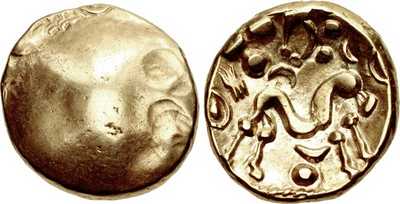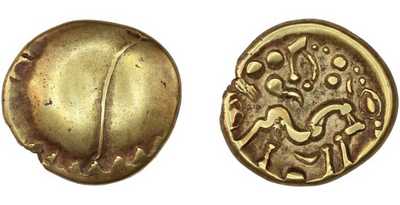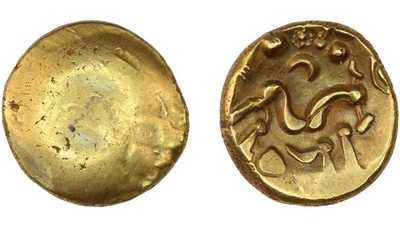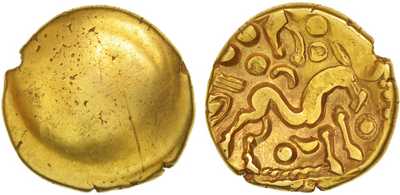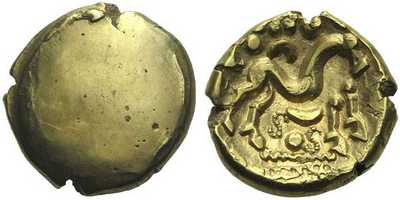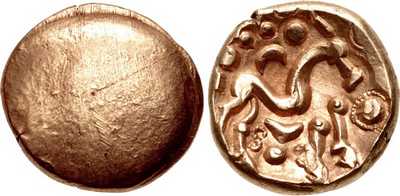| Back to Gallo Belgic C | This page is part of the article Getting Started with Celtic Coins | Forward to Gallo Belgic F and Gallo Belgic G |
About Gallo-Belgic E
Gallo-Belgic E coins survive in large numbers and are probably the cheapest Celtic gold stater you can buy. This, together with their interesting story, makes them good coins to collect, so I’ll go into a bit more detail than normal here.
The Gallo-Belgic C coins ended at the start of the Gallic Wars when Caesar attacked Gaul. They were replaced with Gallo-Belgic E (58-50 BC) which is possibly the largest series ever minted by the Celts. At the time of writing (2019) there are 1,019 known reverse dies, and over 2,100 known coins, leading to an estimate of 2,314 reverse dies (technically, somewhere between 1,778 and 3,318 dies, with 95% confidence). Assuming that one die could make 1,000 coins, total production would have been around 2.3 million coins.
The early staters die link to Gallo-Belgic Ca, so are assigned to the Ambiani, but they were almost certainly minted, or at least financed, by the coalition of tribes at war with Caesar. It would take around 8,330Kg of gold to mint Gallo-Belgic E and it was unlikely that the Ambiani could manage this on their own, even if they recalled all of the Gallo-Belgic Ca coins and melted down their treasure reserves. The uniface design, whereby the obverse is blank, also suggests they were minted by a coalition of tribes.
Simone Scheers identified six different classes of coin (Scheers, “La Gaule Belgique - Traité De Numismatique Celtique”). Dr. John Sills later refined this by introducing some sub-classes, and by splitting class four into two parts. He believes that the seven classes can be mapped to the seven winters of the Gallic war, where coins were minted in preparation to the upcoming summer campaigns (and during the summer if more were required).
| Class | Date | Events |
| 1 | 58/7 BC | 57 BC: Caesar attacks the Belgae |
| 2 | 57/6 BC | 56 BC: Veneti defeated |
| 3 | 56/5 BC | 55 BC: First invasion of Britain |
| 4H | 55/4 BC | 54 BC: Second invasion of Britain |
| 4L | 54/3 BC | 53 BC: British recoinage to pay tribute? |
| 5 | 53/2 BC | 52 BC: Rebellion of Vercingetorix |
| 6 | 52/1 BC | 51 BC: End of Belgic resistance |
While this of course is just a theory, it is widely accepted as a plausible one.
The Coins
Classifying the coins can be difficult as the first four require the exergue to be visible, and this is frequently missing from coins. Sills gives some tips in his article for dealing with these coins, so it’s worth tracking down a copy.
Class 1 – Zigzag
Class 1 coins are defined by the zigzag pattern in the exergue, the top of which is a flat line. The earliest coins in this class have an obverse die link with Gallo-Belgic Ca class 6, and can still show some detail on the obverse.
There are three sub-types in this class, mainly defined by the horse’s stance.
1A – Standing Horse
The ∩ shape above the horse (the remnants of the charioteers arms) is bold in this class, and the horse is standing. The very first coins still have a Gallo-Belgic Ca design on the obverse, but that is allowed to wear flat
1B – Bold ∩
The ∩ shape above the horse is bold in this class, like it was in the previous one, but the horse has a wider stance – the front legs aren’t quite so vertical.
Note that we still have some obverse patterning, suggesting 1A and 1B were minted in parallel
1C – Smaller ∩
The ∩ shape above the horse is smaller in this class, and the horse is running. Its neck is more vertical and the front legs are at a shallower angle.
Class 2 – Arc-and-Pellet/Solid Line
Class 2 coins are defined by the lack of a zigzag pattern in the exergue, the top of which is still a flat line. The first sub-class just has a jumble of shapes in the exergue, but the second and third have arcs and torcs (arcs with pellet ends) respectively.
2A Jumbled Exergue
It has been remarkably difficult to find an example of this type. If you are planning to collect one from each sub-type, then this might be one of the more challenging ones to get
2B Plain Arcs
In this sub-class, the arcs in the exergue have plain ends.
2C Solid Line/Pellet Arcs
In this sub-class, the arcs in the exergue have pellet terminals.
Class 3 – Arc and Pellet/Corded Line
Class 3 coins have a corded line at the top of the exergue, but still have pellets and torcs beneath it. The pellet beneath the horse is closer to the back legs in this class, and the legs can be shorter.
3A – Corded Line/Pellet Arcs
3B – Crescent Arcs
In this sub-type, the arcs in the exergue have crescents in them.
3C – Crude
In this sub-type, the pellet below horse is almost at the back legs. The front legs are short, and the neck sometimes extends over the head. This is perhaps the most identifiable feature.
The ∩ shape above the horse can be large in this sub-type.
Class 4H – Fronds/Heavy
Class 4H coins (the H stands for “Heavy”) have a corded line at the top of the exergue, but below it they have a wavy line between two straight lines. “Fronds” are added at both ends of the exergue (they look like little waving arms).
Example of the exergue:
4H-A Small Figure
In the first sub-type, the ∩ shape above the horse is replaced with a stick figure of a running man, but only on the first die.
4H-B – Wavy Anemone
This sub-type is named after the object behind the horse, which was once its tail. This looks similar to one in the next sub-type (4L-C) but it is more vertical here.
The weight of the coin can also help here. Unworn coins of this type generally weigh more than 6g.
Class 4L – Fronds/Light
Class 4L (the L stands for “Light”) coins are similar to class 4H coins but are lighter, with their mean weight falling below 6g. A ring of fronds can appear on the obverse, and the “anemone” behind the horse (the remains of its tail) becomes more rectangular and more horizontal. Classes 4L-D and 4L-E are easier to identify as they involve obvious changes to the ∩ shape above the horse.
4L-C – Neat Anemone
This sub-type is named after the object behind the horse, which was once its tail. This can appear to be very similar to one in the previous sub-type (4H-B) but it is more horizontal here, and can be more rectangular. The back legs are spread further apart in this sub-type, and later coins of this sub-type have an obvious “notch” in the horse’s rear, just at the top of the leg. Another defining feature of this class is the fronds that appear on the obverse, and the weight of the coin can also help, as the average weight from now on is less than 6g.
4L-D – Pellet Ring
In addition to the features of 4L-C, this sub-type features a pellet ring around the terminal of the ∩ shape’s left arm.
4L-E – Annulet/Rosette
In addition to the features of 4L-C, this sub-type features an annulet around the terminal of the ∩ shape’s right arm. It also features a rosette in front of the horse.
Class 5 – SS Type
Class 5 is the first of the main classes that doesn’t depend on the exergue. Instead, it is defined by the “S” shapes that appear below the horse. Sills defines two sub-types; one with both S’s reversed and one with just one of them reversed. However, coins exist with both S’s facing the correct way, and with only one S. I’ve added these as two new sub-types here.
5A – SS Reversed
5B – One S Reversed
5C – Double S
This coins has neither S reversed. Sills doesn’t mention one like this
5D – Single S
This isn’t mentioned by Sills. The reverse is identical to that of class 6, but the obverse does not have the A motif required for class 6. It’s possible that this is just missing on this coin because the flan was off-centre with respect to the obverse die, in which case this is just a class 6 coin.
Class 6 – A Type
The final class is defined by an A shape on the obverse. There is some debate as to whether this is an “A”, an “AT” monogram, or a reversed digamma symbol (originally the 6th letter of the Greek alphabet). The Celts didn’t speak Greek, and the Greeks had stopped using it before 500 BC, so “A” or “AT” are much more likely. There is a very rare quarter stater associated with class 6 that has AR on the reverse, which could make this ATR. In 55/4 BC the Romans spent the winter in Belgic territory, and in the winter of 54/3 BC Caesar stayed in the capital city of the Ambiani. It’s likely that coin minting moved to other territories, and the closest tribe that was furthest from the Romans was the Atrebates.
6 – Digamma/Single S
Further Reading
For such a large and important series of coins, there’s surprisingly very little in the way of literature about them. The most useful is a five page article by Dr. John Sills called “Identifying Gallic War Uniface Staters”, which was published in Chris Rudd List 83 (2005). This is where he defines the classes and gives tips on how to work out which class a coin belongs to. He talks a little about Gallo-Belgic E in “Gaulish and Early British Gold Coinage”, but only in the context of Gallo-Belgic C. He also discusses them briefly again in “Divided Kingdoms: The Iron Age Gold Coinage of Southern England”.
For those of you who read French, Simone Scheers covers Gallo-Belgic E in her book “La Gaule Belgique - Traité De Numismatique Celtique”, but her work has been superseded by that of Sills.
Article Navigation
| Back to Gallo Belgic C | Up to Third Generation Coins (c. 125 BC to c. 50 BC) | Forward to Gallo Belgic F and Gallo Belgic G |
